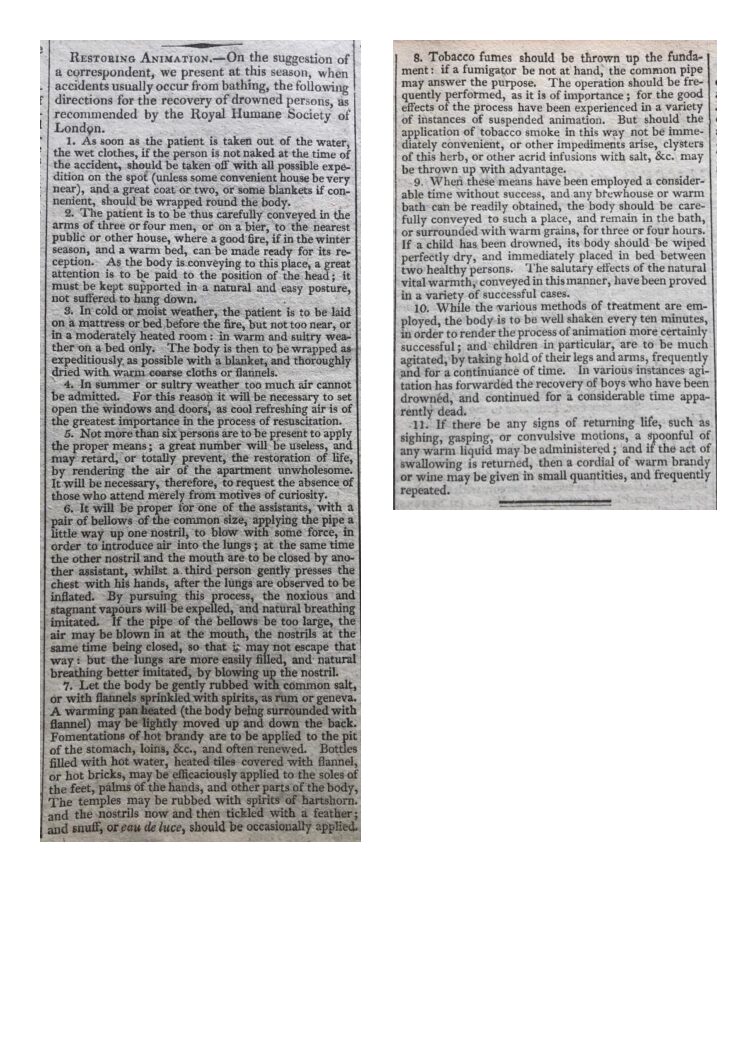The procedure set out to ‘restore animation’, albeit it specific and detailed, would, we think, have taken rather too long to administer. Or course, we know now that the important thing is to give CPR as soon as possible.
“RESTORING ANIMATION. – On the suggestion of a correspondent, we present at this season, which accidents usually occur from bathing, the following directions for the recovery of drowned persons, as recommended by the Royal Humane Society of London.
- As soon as the patient is taken out of the water, the wet clothes, if the person is not naked at the time of the accident, should be taken off with all possible expedition on the spot (unless some convenient house be very near), and a great coat or two, or some blankets if convenient, should be wrapped round the body.
- The patient is to be thus carefully conveyed in the arms of three or four men, or on a bier, to the nearest public or other house, where a good fire, if in the winter season, and a warm bed, can be made ready for its reception. As the body is conveying to this place, a great attention is to be paid to the position of the head; it must be kept supported in a natural and easy posture, not suffered to hang down.
- In cold or moist weather, the patient is to be laid on a mattress or bed before the fire, but not too near, or in a moderately heated room: in warm and sultry weather on a bed only. The body is then to be wrapped as expeditiously as possible with a blanket, and thoroughly dried with warm coarse cloths or flannels.
- In summer or sultry weather too much air cannot be admitted. For this reason it will be necessary to set open the windows and doors, as cool refreshing air is of the greatest importance in the process of resuscitation.
- Not more than six persons are to be present to apply the proper means; a great number will be useless, and may retard, or totally prevent, the restoration of life, by rendering the air of the partment unwholesome. It will be necessary, therefore, to request the absence of those who attend merely from motives of curiosity.
- It will be proper for one of the attendants, with a pair of bellows of the common size, applying the pipe a little way up one nostril, to blow with some force, in order to introduce air into the lungs; at the same time the other nostril and the mouth are to be closed by another assistant, whilst a third person gently presses the chest with his hands, after the lungs are observed to be inflated. By pursuing this process, the noxious and stagnant vapours will be expelled, and natural breathing imitated. If the pipe of the bellows be too large, the air may be blown in at the mouth, the nostrils at the same time being closed, so that it may not escape that way: but the lungs are more easily filled, and natural breathing better imitated, but blowing up the nostril.
- Let the body be gently rubbed with common salt, or with flannels sprinkled with spirits, as rum or geneva. A warming pan heated (the body being surrounded with flannel) may be lightly moved up and down the back. Fomentations of hot brandy are to be applied to the pit of the stomach, loins, &c., and often renewed. Bottles filled with hot water, heated tiles covered with flannel or hot bricks, may be efficaciously applied to the soles of the feet, palms of the hands, and other parts of the body, The temples may be rubbed with spirits of hartshorn. and the nostrils now and then tickled with a feather; and snuff, or eau de luce*, should be occasionally applied.
- Tobacco fumes should be thrown up the fundament: if a fumigator be not at hand, the common pipe may answer the purpose. The operation should be frequently performed, as it is of importance; for the good effects of the process have been experienced in a variety of instances of suspended animation. But should the application of tobacco smoke in this way not be immediately convenient, or other impediments arise, clysters of this herb, or other acrid infusions with salt, &c. may be thrown up with advantage.
- When these means have been employed a considerable time without success, and any brewhouse or warm bath can be radily obtained, the body should be carefully conveyed to such a place, and remain in the bath, or surrounded with warm grains, for three or four hours. If a child has been drowned, its body should be wiped perfectly dry, and immediately placed in bed between two healthy persons. The salutary effects of the natural vital warmth, conveyed in this manner, have been proved in a variety of successful cases.
- While the various methods of treatment are employed, the body is to be well shaken evey ten minutes, in order to render the process of animation more certainly successful; and children in particular, are to be much agitated, by taking hold of their legs and arms, frequently and for a continuance of time. In various instances agitation has forwarded the recovery of boys who have been drowned, and continued for a considerable time apparently dead.
- If there be any signs of returning life, such as sighing, gasping, or convulsive motions, a spoonful of any warm liquid may be administered; and if the act of swallowing is returned, then a cordial of warm brandy or wine may be given in small quantities, and frequently repeated.”
The Stamford Mercury, 22nd June, 1821.
*volatile liquid soap, with a strong pungent smell.

